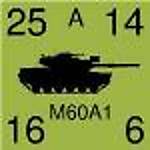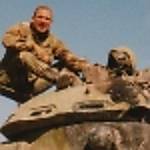






Quoted TextOn the other hand, Modelers who just want a late Vietnam Sheridan can go with Tamiya’s kit.
Late? No, not really. Other than the optional birdcage armor, the Tamiya kit has features of an early M551.



Russ, I see what looks like some link and length tracks here. Are these vehicle mounted spare links?
What format are the tracks offered in for this model?

Quoted TextOn the other hand, Modelers who just want a late Vietnam Sheridan can go with Tamiya’s kit.
Late? No, not really. Other than the optional birdcage armor, the Tamiya kit has features of an early M551.

Quoted TextQuoted TextOn the other hand, Modelers who just want a late Vietnam Sheridan can go with Tamiya’s kit.
Late? No, not really. Other than the optional birdcage armor, the Tamiya kit has features of an early M551.
Pavel,
Yes, it is an early version, but what I was referring to was the inclusion of the appliqué armor, which was added "later" in Vietnam, and the missing large bore evacuator that was present on the "early" M551 as produced in 1966, which is the "earliest" production model. The presence of the small tube and addition of the appliqué armor make the Tamiya Sheridan a "little later" version, but you're right-- it's still a Vietnam M551--just not a "very early" one.
VR, Russ







There were actually two problems "afoot" with the gun launcher system. The first was the failure of the Open Breech Scavenger System (OBSS) on the original production M551. This system allowed burning remnants of the "caseless" ammunition system to remain in the tube, and to even be drawn into the turret when the breech opened. Tracks with this system had a "large" bore evacuator and many made it to Vietnam. Later, they were retro-fitted with the Closed Breech Scavenging System, which was added to all vehicles. On "newer" CBSS vehicles coming off the production line, the older barrels were used which had a "ring" reinforcement for the older bore evacuator. But later, this barrel became a "smooth" barrel with no projections (the Tamiya kit has the "mid-production" barrel with the ring).
The breech problem Gary is referring to was discovered later, and involves cracks in the breech ring developing in older barrels, resulting from repeated firing of the heavy "caseless" ammo. This was a major issue, and beginning in 1974, as Gary mentions, many of these vehicles received new barrels. Post 1972, as they went back for rebuild, they also received the M55A1 upgrade. My track, Fox 36, in '77-78, was a Vietnam hull (still had holes from small arms fire patched on the sides), rebuilt with a new turret and barrel with a LRF, bringing it up to M551A1 standard (well, for a while, until I lost the LRF in a firing range "accident", so I guess my track reverted to an M551-sort of?). This was "par for the course" in the '70s. We traded in older M551s for newer A1 rebuilds all the time, usually two at a time, when they became overmilage (which included keeping track of the rounds downrange for barrel wear).
But, there were other problems with the gun tube beside cracks. Deformed obturator seals (it had an Artillery-like breech), jammed detent buttons (kept the missile or projectile from slipping backwards out of the tube), broken screw-drive motors were commonplace, and sometimes had serious repercussions, dead-lining the track. In all, the M551 was a complicated, finicky beast, demanding hours of care and maintenance. But it was also fun to ride on and operate--when everything was operating well.
VR, Russ











Could anyone post some photos of hull repairs from small arms damage? It could be a cool addition to building the kit.






Was the turret any better?




By the way there was little need for an RPG screen on the front due to the shape. Nearly all CBL'd Sheridan's were hit directly to the side or ran over a mine. Many were lost to the autoloader/gun launcher failure. Allowing the neighbors to get close.
Gary
If my memory holds, I talked to those years ago that said the "RPG" fencing was used not for RPG's but to keep the snakes and other critters and stuff out of the drivers lap as they moved through the brush.
A good diorama would be having the crew using sticks to get a cobra unwound from the fencing with the tank sitting in the brush and a lot of leaves and stuff on the front slope. The gunner threatening to use the main gun on the ctobra in the fencing if they don't get it off.

Could anyone post some photos of hull repairs from small arms damage? It could be a cool addition to building the kit.

Quoted TextWas the turret any better?
The turret was ballistic steel, so it was considerably better. The hull was aluminum, but what you see above the roadwheels is actually a thin "skin" riveted to a frame, which covers an inner core of extruded eurethane foam. This, along with the folding rubberized fabric shields, is what gave the Sheridan its amphibious capability. It also provided some "standoff" from the shaped charge of an RPG. The Sheridan was never intended to be a "tank" it was a lightweight reconnaissance vehicle. We never called it a "tank", although it had the ability to knock out any known tank of the day, with the missile (under the right conditions) and that massive artillery piece of a gun. But the gun played havoc with that lightweight hull, and the components inside.
VR, Russ

The inner hull of the Sheridan was an extremely well sloped welded aluminum armor box. As Russ said the outer hull was a layer of foam with a sheet aluminum skin. The turret was welded steel. As a student in Sheridan school at Fort Knox I was dismayed to hear that a 50cal AP round could pierce our armor. Our instructed said I pity the guys who shoot at me with a 50cal since they are getting a 152mm HEAT round back. If you look inside the kits sponson boxes on the rear hull you can see the slope of the inner hull. The hatch in the right side sponson box is actually the hatch over the battery box.
Tom

The inner hull of the Sheridan was an extremely well sloped welded aluminum armor box. As Russ said the outer hull was a layer of foam with a sheet aluminum skin. The turret was welded steel. As a student in Sheridan school at Fort Knox I was dismayed to hear that a 50cal AP round could pierce our armor. Our instructed said I pity the guys who shoot at me with a 50cal since they are getting a 152mm HEAT round back. If you look inside the kits sponson boxes on the rear hull you can see the slope of the inner hull. The hatch in the right side sponson box is actually the hatch over the battery box.
Tom
 |